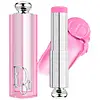What's inside
What's inside
 Key Ingredients
Key Ingredients

 Benefits
Benefits

 Concerns
Concerns

 Ingredients Side-by-side
Ingredients Side-by-side

Talc
AbrasiveDiisostearyl Malate
EmollientTriethylhexanoin
MaskingHydrogenated Castor Oil Isostearate
Skin ConditioningPolyglyceryl-3 Polydimethylsiloxyethyl Dimethicone
Skin ConditioningZinc Laurate
Methylparaben
PreservativeTocopherol
AntioxidantOlea Europaea Fruit Oil
MaskingCeramide NP
Skin ConditioningButyrospermum Parkii Butter
Skin ConditioningSimmondsia Chinensis Seed Oil
EmollientMica
Cosmetic ColorantCI 77492
Cosmetic ColorantCI 45380
Cosmetic ColorantAluminum Hydroxide
EmollientTitanium Dioxide
Cosmetic ColorantRosa Canina Fruit Oil
EmollientTin Oxide
AbrasiveUltramarines
Synthetic Fluorphlogopite
Talc, Diisostearyl Malate, Triethylhexanoin, Hydrogenated Castor Oil Isostearate, Polyglyceryl-3 Polydimethylsiloxyethyl Dimethicone, Zinc Laurate, Methylparaben, Tocopherol, Olea Europaea Fruit Oil, Ceramide NP, Butyrospermum Parkii Butter, Simmondsia Chinensis Seed Oil, Mica, CI 77492, CI 45380, Aluminum Hydroxide, Titanium Dioxide, Rosa Canina Fruit Oil, Tin Oxide, Ultramarines, Synthetic Fluorphlogopite
Polyglyceryl-2 Triisostearate
EmulsifyingSqualane
EmollientHydrogenated Polydecene
EmollientDimer Dilinoleyl Dimer Dilinoleate
EmollientHelianthus Annuus Seed Wax
Skin ConditioningMica
Cosmetic ColorantCera Alba
EmollientTrimethylolpropane Triisostearate
EmollientCopernicia Cerifera Wax
Diisostearyl Malate
EmollientParfum
MaskingEthyl Vanillin
MaskingPrunus Avium Seed Oil
EmollientPentaerythrityl Tetra-Di-T-Butyl Hydroxyhydrocinnamate
AntioxidantMenthol
MaskingVanillin
MaskingAluminum Hydroxide
EmollientMentha Piperita Oil
MaskingPropyl Gallate
AntioxidantCI 77891
Cosmetic ColorantCI 45410
Cosmetic ColorantCI 15850
Cosmetic ColorantPolyglyceryl-2 Triisostearate, Squalane, Hydrogenated Polydecene, Dimer Dilinoleyl Dimer Dilinoleate, Helianthus Annuus Seed Wax, Mica, Cera Alba, Trimethylolpropane Triisostearate, Copernicia Cerifera Wax, Diisostearyl Malate, Parfum, Ethyl Vanillin, Prunus Avium Seed Oil, Pentaerythrityl Tetra-Di-T-Butyl Hydroxyhydrocinnamate, Menthol, Vanillin, Aluminum Hydroxide, Mentha Piperita Oil, Propyl Gallate, CI 77891, CI 45410, CI 15850
Ingredients Explained
These ingredients are found in both products.
Ingredients higher up in an ingredient list are typically present in a larger amount.
Aluminum Hydroxide is a form of aluminum. It can be naturally found in nature as the mineral gibbsite. In cosmetics, Aluminum Hydroxide is used as a colorant, pH adjuster, and absorbent.
As a colorant, Aluminum Hydroxide may add opacity, or reduce the transparency. Aluminum hydroxide is contains both basic and acidic properties.
According to manufacturers, this ingredient is an emollient and humectant. This means it helps hydrate the skin.
In medicine, this ingredient is used to help relieve heartburn and help heal ulcers.
There is currently no credible scientific evidence linking aluminum hydroxide in cosmetics to increased cancer risk.
Major health organizations allow the use of aluminum hydroxide in personal care products and have not flagged it as a carcinogenic risk at typical usage levels.
Learn more about Aluminum HydroxideDiisostearyl Malate is an emollient and most often used in lip products. It comes from isostearyl alcohol, a fatty acid, and malic acid, an AHA.
As an emollient, Diisostearyl Malate helps create a thin film on your skin to trap moisture in. This helps keep your skin soft and smooth.
Mica is a naturally occurring mineral used to add shimmer and color in cosmetics. It can also help improve the texture of a product or give it an opaque, white/silver color.
Serecite is the name for very fine but ragged grains of mica.
This ingredient is often coated with metal oxides like titanium dioxide. Trace amounts of heavy metals may be found in mica, but these metals are not harmful in our personal products.
Mica has been used since prehistoric times throughout the world. Ancient Egyptian, Indian, Greek, Roman, Aztec, and Chinese civilizations have used mica.
Learn more about Mica